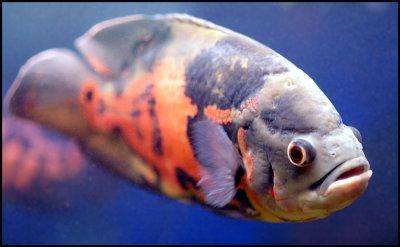Species: (South American) Hypselecara temporalis "Chocolate Cichlid"
Size: 10-12" for both Sexes, Males can be slightly larger.
Temperament: Generally peaceful unless spawning. Definitely to be considered a gentle giant, however they will not hesistate to back themselves if threatened. They're certainly not a small fish and they can use their body size to their advantage, however their mouths, although large, aren't developed for dealing damage.
Tank size: 4'x18" footprint minimum in my opinion. Could get away in a largish volume 4'x15" footprint tank however they are messy eaters and will put strain on the bioload of your tank.
Diet: A typical varied diet supplemented with vegetable matter. Very keen feeders and will take all pellets, and most vegetables including Peas, Romaine Lettuce, Zucchini, Cucumber, Pumpkin. Chocolate's absolutely love insects, their natural source of nutrition and will constantly watch the water surface waiting for bugs to land. If you run lights at night time on an open tank be prepared for water splashes as small insects will land on the water and will be taken. As keepers of Chocolates will know, this is why they generally 'cruise' around on a 45 degree upwards angle while swimming, as they're scanning the surface.
Sexing: Males have extended dorsal, anal and pelvic fins like most CA/SA Species. Nearing adulthood, the Males will also develop a somewhat prominent Nuchal hump, though it's not what you're typically used to with most CA/SA Predators.
Water parameters: Like most South Americans, Soft water, though like most fish in the hobby they are fine in most well kept water. Ideally a pH of around 6-7 with very low general hardness, however will do fine in neutral water up to around 8pH.

7" Male

Male at 6"

Adult Female (Hosted at Cichlidae.com)
Size: 10-12" for both Sexes, Males can be slightly larger.
Temperament: Generally peaceful unless spawning. Definitely to be considered a gentle giant, however they will not hesistate to back themselves if threatened. They're certainly not a small fish and they can use their body size to their advantage, however their mouths, although large, aren't developed for dealing damage.
Tank size: 4'x18" footprint minimum in my opinion. Could get away in a largish volume 4'x15" footprint tank however they are messy eaters and will put strain on the bioload of your tank.
Diet: A typical varied diet supplemented with vegetable matter. Very keen feeders and will take all pellets, and most vegetables including Peas, Romaine Lettuce, Zucchini, Cucumber, Pumpkin. Chocolate's absolutely love insects, their natural source of nutrition and will constantly watch the water surface waiting for bugs to land. If you run lights at night time on an open tank be prepared for water splashes as small insects will land on the water and will be taken. As keepers of Chocolates will know, this is why they generally 'cruise' around on a 45 degree upwards angle while swimming, as they're scanning the surface.
Sexing: Males have extended dorsal, anal and pelvic fins like most CA/SA Species. Nearing adulthood, the Males will also develop a somewhat prominent Nuchal hump, though it's not what you're typically used to with most CA/SA Predators.
Water parameters: Like most South Americans, Soft water, though like most fish in the hobby they are fine in most well kept water. Ideally a pH of around 6-7 with very low general hardness, however will do fine in neutral water up to around 8pH.

7" Male

Male at 6"

Adult Female (Hosted at Cichlidae.com)














